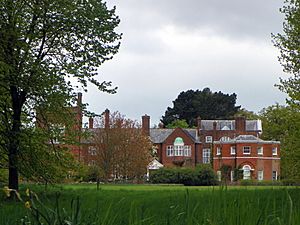Elizabeth Parish facts for kids
Elizabeth Parish (born Planta; 1740/41 – 1823) was a governess and lady's companion from Switzerland who worked in England. Her father, Andreas Planta, was a Swiss pastor who later became an assistant librarian at the British Museum. Her brother, Joseph Planta, became the main librarian there.
Elizabeth worked for the Bowes-Lyon family for many years. She was first a governess for Mary Eleanor Bowes. Later, she became a companion to Mary Eleanor's mother, Mary Bowes. Elizabeth also taught Mary Eleanor's children. She left their service in 1776 and received a large payment of £2,000.
In 1777, she married John Parish, who worked for the Board of Ordnance and was a member of the Society of Antiquaries of London. She returned to work for the Bowes-Lyon family in 1785. This time, she was a governess for Mary Eleanor's daughter, Anna Maria Bowes. Anna Maria eloped in 1788 while under Elizabeth's care. Elizabeth moved to Gibraltar with her husband in 1791. After he died, she returned to England. She passed away in Petersham in 1823. Two books of music written by her are kept in Italy at the Accademia Nazionale di Santa Cecilia.
Contents
Early Life and Family
Elizabeth Planta was born in 1740 or 1741. Her father, Andreas Planta, was a Swiss pastor. At the time, he was working in Castasegna, a Swiss town where many people spoke Italian and were Protestant. Her mother was Margarete Scartazzini de Bolgiani.
Elizabeth had several sisters, including Frederica Planta. Frederica later became a governess and English teacher for the daughters of George III and Queen Charlotte. Elizabeth also had a brother, Joseph Planta, who became the main librarian at the British Museum.
In 1752, her family moved to London. Her father became a pastor at the German Reformed church in the Savoy Chapel. In 1758, he also started working as an assistant librarian at the British Museum. Even while living in London, the family continued to speak their native language, Romansh, at home.
Working for the Bowes-Lyon Family
Starting in 1757, Elizabeth Planta worked for the Bowes-Lyon family. She was a governess for eight-year-old Mary Eleanor Bowes. Her father also taught Mary Eleanor French. Elizabeth was not only Mary Eleanor's teacher but also her chaperone. She went with Mary Eleanor to cultural events.
In 1760, Mary Eleanor's father, George Bowes, passed away. Mary Eleanor then inherited a huge fortune. Her mother, Mary (née Gilbert) Bowes, left London. So, Mary Eleanor was raised by her aunt, Jane Bowes, along with Elizabeth and other teachers. During this time, Elizabeth and her father may have helped Mary Eleanor develop her lifelong interest in plants.
Elizabeth worked as a governess until 1767. That year, Mary Eleanor married John Lyon. He took her last name, Bowes. Elizabeth had advised against this marriage. However, she stayed with the family. She became a lady's companion to Mary Eleanor's mother, Mary Bowes. Elizabeth often went to the opera with her.
Elizabeth and the younger Mary Eleanor kept in touch by writing letters in French and Italian. In 1771, Elizabeth was offered a job as an English teacher for the daughters of King George III and Queen Charlotte. She turned it down, hoping for better opportunities with the Bowes family. Her sister Frederica then took the job at court.
In 1774, Elizabeth returned to work for Mary Eleanor. She became the governess for Mary Eleanor's children. After Mary Eleanor's first husband died in 1776, Elizabeth and the children lived at St Paul's Walden Bury. Mary Eleanor stayed in London.
Later that year, Mary Eleanor decided to let Elizabeth go. She gave Elizabeth £2,000, a very generous amount. Mary Eleanor said she wanted to end their long working relationship on good terms. Elizabeth's 19-year-old sister, Eliza Planta, was then hired as the new governess.
In 1785, Elizabeth Parish returned to work for the Bowes family again. Mary Eleanor's daughter, Anna Maria, was placed in Elizabeth's care. Anna Maria was 16 years old. Elizabeth was known for being very religious and strict. She watched Anna Maria closely and even took away a book she thought was not suitable for a young person.
However, Elizabeth did not notice that Anna Maria was exchanging secret love letters. These letters were with Henry Jessop, a young lawyer who lived across the street. Anna Maria had only seen him from her window. In January 1788, Anna Maria climbed across a plank from her window to Jessop's window. They then eloped and got married on January 28. The local newspaper reported that Elizabeth had "not the least suspicion" about their plans.
Marriage and Later Life
On March 30, 1777, Elizabeth Planta married John Parish. He was the Superintendent of Ordnance at the Tower of London. They did not have any children. John Parish became a member of the Society of Antiquaries in 1778.
In 1791, John became an Ordnance Storekeeper in Gibraltar. Elizabeth and John moved there together. After her husband died in 1798, Elizabeth returned to England. She passed away in Petersham on April 24, 1823, at the age of 82.
Music She Collected
Elizabeth Parish was interested in music. Two books of music with her handwriting are kept at the Accademia Nazionale di Santa Cecilia in Italy. These books are part of a music collection given by Giovanni Matteo Mario.
The first book has 34 vocal music pieces. This includes 18 songs by Maurice Greene. It also has music by other composers like Agostino Steffani and Johann Christian Bach. Most of the songs are in Italian. It is thought that Elizabeth learned about Greene's music from Mary (née Gilbert) Bowes. Mary had performed in one of Greene's operas before she got married.
The second book is called Italian Songs. It contains music from operas that were performed in London between 1765 and 1777.



